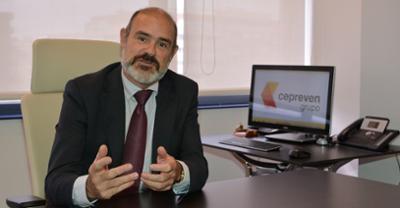

Jon Michelena (Cepreven): “The fire prevention system sector is undergoing a transformation”
The fire prevention sector is undergoing a transformation thanks to the progress in digitalising processes, mainly regarding maintenance of the installations, as stated in the following interview with Jon Michelena Muguera, General Director of Cepreven (Investigation Association for the Safety of Lives and Assets).
What are the new challenges and demands for fire prevention at the moment?
Construction in general is undergoing a significant transformation, given the need to create sustainable buildings that are energy-neutral, that help to mitigate climate change and contribute to reducing the CO2 footprint. This means that most of the apartment buildings which until recently were constructed with traditional materials such as steel, brick and concrete, are currently being built with façade and interior insulation systems that, in many cases, are combustible.
The technical building code, in its basic document on fire safety, has updated the requirements for façade materials in new buildings. They must have certain features pertaining to combustibility and be part of a construction system that limits potential spreading of a fire on the façade. However, there are many buildings dating from before 2021 that still have combustible façade systems.
Fires like the Torre del Moro in Milan or the Grenfell Tower in London are examples of how fire propagation on the façade can completely destroy a building and, in the case of London, cause a number of victims that is inconceivable to date in a building of that nature. The closest examples are those in Madrid in the last two years, in the Torre Ambar and the hotel Nuevo Madrid, which were controlled in time by the fire-fighters and where there were no victims and the damage was limited.
Work must continue to have incombustible systems installed, which have been on the market for a long time, or when combustible systems are chosen, they should be properly selected and installed under the conditions established by the manufacturer, according to the tests performed.
What is your opinion on photovoltaic panel installations?
The use of photovoltaic panel installations on roofs and façades is another concern for prevention agents. In addition to the problems caused by batteries, which I will analyse further ahead, the panels generate high voltages that could lead to short-circuits or other electrical problems that could start a fire. If the roof’s thermal insulation systems were not properly designed or date from before the photovoltaic installation, they may be combustible and spread the fire to the entire roof and from there to the entire building.
Lithium batteries store a large amount of energy and if the dielectric is punctured, it causes overheating that could lead to a fire that is very difficult to put out. One of the major challenges for the fire prevention industry and for battery manufacturers is to find a truly efficient system to control lithium battery fires or batteries that do not have this problem.
In the near future, electric vehicles will become the mobility standard. We must make sure that parking them in garages in communities and charging them will not entail a real hazard for the building residents.
What is the situation of the various industrial areas?
Regarding industries, the recycling sector needs to improve its fire protection. Storage systems, in trenches, in large basins or other generally variable containers, as well as the frequent difficulty in knowing exactly what materials are being stored, give rise to multiple doubts on which system would be ideal to control or extinguish a fire. This aspect should be discussed both at a technical and legislative level.
Another great challenge is protecting major industrial constructions, such as large logistics platforms. In most cases these buildings do not fit into current legislation on fire prevention. The trend to successfully complete the project with proper safety guarantees is to use the “Feature-based design”, considering all of the building characteristics in a holistic manner, so that there are guarantees for safety, evacuation and the building adapts to the envisaged production processes.
This design system is explicitly contained in the Technical Building Code and it will also be in the new edition of the Safety Regulations against Fires in Industrial Premises.
Regardless of the above, the main challenge for prevention professionals is to raise awareness in the population in general of the need to prevent fires and for people, who are usually aware that they can be robbed or that they could have a car accident, to also be aware that at any moment a fire may break out in their home or at their workplace and how they should act to minimise it.
In general, what are the latest trends and innovations in the fire prevention sector?
In addition to the feature-based designs that were approached from Protection Engineering against fires and discussed in the above question, the sector is undergoing a transformation thanks to the progress on digitalising processes, mainly regarding maintenance of the installations, with the purpose to make it easier, optimise time and costs and, especially, to maintain traceability of all the activities involved in the process.
The main innovations are coming through electronics and communications. Detection systems are much more versatile, whether with sensors, cameras with artificial intelligence that can identify fires, thermal imaging cameras specific for detection, centres that can manage evacuation with signals that adapt to the availability of the evacuation paths, systems connected to the cloud... Technology developed along two lines: on the one hand to improve speed and reliability in detection and on the other hand to make it easier for owners, installers or maintenance staff to manage the systems
The fire reception centre (FRC) was also created to manage alarms in specialised centres that enable more efficient responses.
Companies continue researching, improving their equipment or creating other completely new equipment, although the new systems find it hard to fit in with the rigid Spanish legislation on fire prevention.
What other industry areas or concerns would you consider significant right now?
One of the main problems of the fire prevention industry is the lack of professionalism in many companies. In spite of the fact that legislation establishes the minimum requirements that a company must meet, too often they are only met on paper. Control by the government is not enough, due to lack of resources. This means that there are too many unfair competition situations, where maintenance services are offered at minimum costs, which in no case fulfil the obligations contained in the fire prevention installation regulations.
All of the legislative framework on Fire Prevention, which makes it mandatory for companies to install systems that they often do not want or understand, and which enables companies to be on the market without performing the work that they should, leads to both of these meeting, generating all of the necessary paperwork, and that the protection required by the legislator is neither there nor expected.
As long as end users do not fully appreciate that fire safety is an investment and that maintaining fire prevention systems is as necessary as production systems, the goal will not be met, regardless of however much legislation is created.





